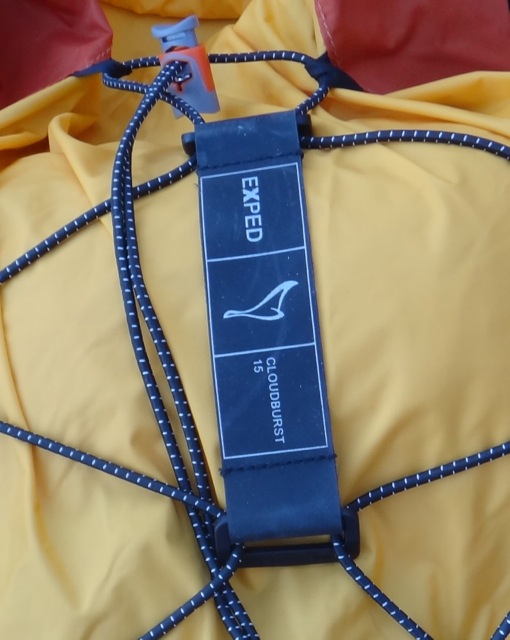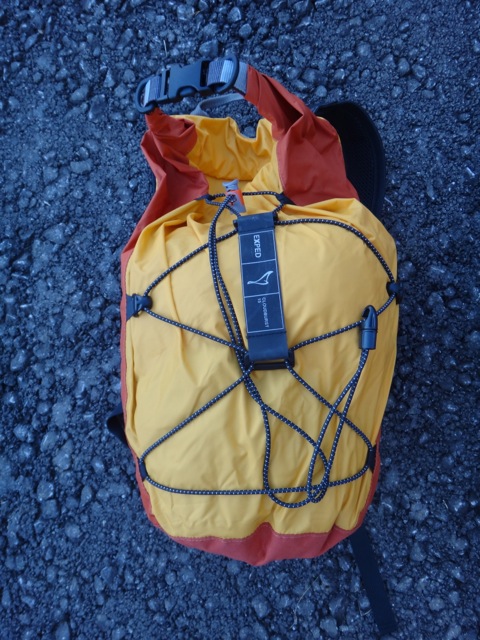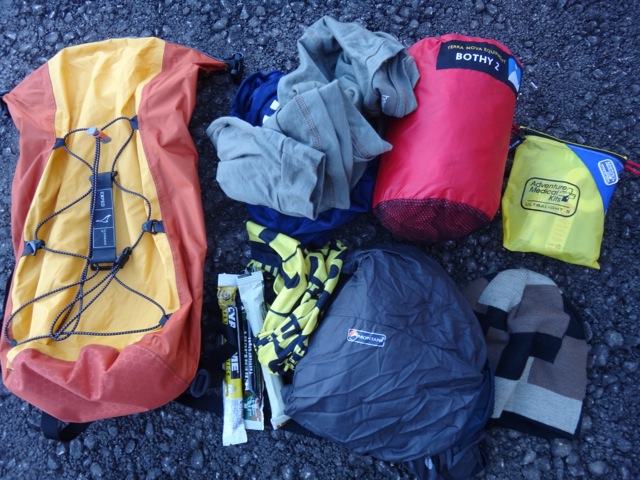As well as making sure I have all the necessary safety kit (PFD, helmet, throw line, whistle, pin kit) I like to have a range of kit with me that can be used in emergency situations. If a trip were to turn into an epic it is possible that someone may have been injured and/or we could be stuck out in the middle of nowhere.
Therefore my kit centres around three key elements/purposes:
I like to carry a range of kit that will help keep me and/or my paddling buddies warm and offer a little shelter.
If someone gets injured I’d like to go someway to help patch him or her up.
I’d like to ensure that morale stays high.
I have to weigh all of these needs against what is practically possible and the weight I can actually carry in my boat. Regardless this kit needs to be carried in my boat or on my person and needs to be kept dry. I am currently using an Exped Cloudburst dry sack for the bulk of the emergency kit that I carry. It is based around a traditional roll top dry bag but it has straps so that it can be used as a rucksack. It has a volume of 15 litres which means it is big enough to hold the essentials but will still fit in the back of my Liquid Logic Stomper.
What you choose to carry will be dependent on the area your paddle in. I spend most of my time paddling in the UK where help isn’t too far away. I have therefore selected kit that would cope with most eventualities including being stuck out in the wilds over night.
Here’s the kit that is in the Cloudburst. From top left – 2 x thermals, Terra Nova Bothy Bag, a small waterproof first aid kit (Adventure Medical Kit 5), a hat, a Montane Pertex top (which packs super small), a buff, and a few Cyalume sticks. Out of shot is also a small 180 lumen waterproof torch, a pack of waterproof matches and a pair of wool gloves.
A Bothy (Bothie) Bag can be best described as a large ripstop nylon box with the bottom missing. They can be picked up fairly cheaply online and from most good outdoor shops. It allows several people to take shelter together. Back in the day the big orange survival bag may have been the preferred option but this can only really provide shelter for one/two people. In situations where someone is injured or the group can’t move on there is a great danger of other members of the group taking ill with, for example, hypothermia if they are not protected and under cover. Having said all of that a big orange survival bag is better than nothing at all, they take up very little room and weigh little.
Keeping warm burns up valuable energy even when standing still so I also like to carry a few snacks (these are placed in my PFD). If out with a larger group I would substitute the two man bothy for a four man version. I plan to add a few bits and bobs to the kit over the course of the next few days and would be happy to hear other peoples suggestions on what to add to my basic setup.
Update:
The following have been added to the bag















I have a 1 litre nalgene in front of the bulkhead in all of my boats.
It contains an emergency blanket, candles, firestarter, water purification, lighter/matches, a powerbar and a headlamp with extra batteries.
One unexpected overnighter taught me a thing or two.
First is water purification. We had none and that was the worst.
2nd, If you can keep a fire going, you will stay warm, at least here in the SE.
The last was a good light. I always have two on me now when i paddle (and i usually checked the batteries every few trips)
With a good light between us, we could have hiked out of the gorge.
The rescue kit is admittedly minimalistic, but light and fast is how i backpack also and i still feel its all i would need.
Situations are different in Iceland. No strainers and more daylight than in most other places. This – plus some other things – mean that you don´t really have to carry as much gear as you would normally do in most other countries.
I carry some basic things with me. A waterproof first aid kit, a knife, energy bar (or a small bag of mixed nuts & raisins), 2-3 carabiners, prussics and a throwbag. You can drink all natural water so purification is not necessary.
If I were to add to this, it would be more food and extra layers of clothing.
Have you thought about adding a line and a hook to your kit? Weighs almost nothing but if you´re lucky that fish will fill your stomach.
Cheers
I always wounder where would i put all this kit on my M Burn, Does deflating my air bag almost flat matter when it is going to be replaced with something other than water ?
The space the kit takes up will prevent water taking its place in a similar way that an airbag does. You can also trap air within the dry bag if you are worried about compromising your buoyancy.
I add my kit bag and re-inflate the buoyancy bag to help keep my bag locked in.
You can easily load a ‘when it all goes wrong kit’ in a M burn. We run 2 week multi river self support trips and you can get all the stuff you need easily in a Burn, so a small bag like this is no issue. In the UK I run a small bag in Nepal and India a much larger bag.
Its already been said but Flint and steel as well as matches. A fire will at the very least take the chill off. Good knife maybe even some sort of basic repair kit
Very true. For me my knife is a standard part of my kit. I have a light my fire steel that works well and is light enough that carrying it isn’t an issue.
The Adventure first kit does have a few bits and bobs inc Gaffa tape that can be used for kit repair. However this is one area of kit that I’d really like to get sorted ASAP.
Even in my little playboat, if we’re heading out of sight of our basecamp/centre then I will be carrying spare kit in case shit hits the fan. I almost always wear my harness & cowtail with a sling and crab in the front pocket of my BA and another tucked under the waist on my Cag. Then have a whistle and a knife in the top pockets and maybe an energy gell or chocolate bar in my BA too. (I have an Extrem- very good with lots of pockets).
Although I dont like to wear one most of the time, I have an earwig under my BA against my chest so it’s warm to put on straight away.
So lets say I take out a larger boat for a descent of a decent bit of river, I will carry (in addition to the above): A First aid kit, a few fleeces and packamack, a flask of hot stuff (in the winter) or a bladder of water in my BA, more food, my river phone, a few more carabinas, a throwline and some duct tape. I have a few little drybags and will always get a bargain if I see one. This way instead of weighing my own boat as a river leader with all this shit, I can distribute it with the whole group (I paddle as part of a uni club and am a little more experienced than many).
I also tend to make up little waterproof cards for when I’m more in the outback. These say the river & stretch, co-ordinates of a nearby hospital as well as the get in and get out. I carry a phone and first aid kit in the hope I never need to use it, but if it goes very bad, I want to focus on administering first aid and send somebody off with the phone to contact help. The help will often not know where the “Middle orchy get-off” is so having these coordinates at hand can really help get an ambulance to you as quick as possible.
Theres also a waterproof survival bag with the first aid kit which comes nearly everywhere too.
Maybe an aluminium mess tin and a few saches of insant tea/coffee? you could probably fit the fleece/first aid kit inside it, and gain a good peice of kit for purifying water/hot drinks for very little space and weight.
Always good to have a cheap lighter or two with you, pretty reliable (if not overly windproof) and again, lightweight and compact.
A phone with charge or a Spot unit. The spot can put out your GPS to the local/international rescue services and tell them you are in need of help. That said it is a one way communication system. Having a phone is great so long as you have signal. Not having one can make even trivial issues, such as getting locked out of your car, become serious. Standing in the cold as it goes dark down a deserted road can quickly get serious. The problem with a phone is you also need to know where you are, and you need to know this in a way in which the emergency services can understand. I have called an ambulance before and I was shocked at how hard it was to get them to understand where I was, and that was literally 5 minuets outside of a town on a major road.